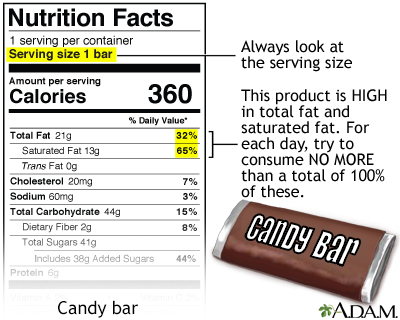Dietary fats explained
Cholesterol - dietary fats; Hyperlipidemia - dietary fats; CAD - dietary fats; Coronary artery disease - dietary fats; Heart disease - dietary fats; Prevention - dietary fats; Cardiovascular disease - dietary fats; Peripheral artery disease - dietary fats; Stroke - dietary fats; Atherosclerosis - dietary fatsFats are an important part of your diet but some types are healthier than others. Choosing healthy fats from vegetable sources more often than less healthy types from animal products can help lower your risk for heart attack, stroke, and other major health problems.
- What are Fats?
Fats are a type of nutrient that you get from your diet. It is essential to eat some fats, though it is also harmful to eat too much.
The fats you eat give your body energy that it needs to work properly. During exercise, your body uses calories from carbohydrates you have eaten. But after 20 minutes, exercise depends partially on calories from fat to keep you going.
You also need fat to keep your skin and hair healthy and help you absorb vitamins A, D, E, and K, which are called fat-soluble vitamins. Fat also fills your fat cells and insulates your body to help keep you warm.
The fats your body gets from your food give your body essential fatty acids called linoleic and linolenic acid. They are called "essential" because your body cannot make them itself, or work without them. Your body needs them for brain development, controlling inflammation, and blood clotting.
Fat has 9 calories per gram, more than 2 times the number of calories in carbohydrates and protein, which each have 4 calories per gram.
All fats are made up of saturated and unsaturated fatty acids. Fats are called saturated or unsaturated depending on how much of each type of fatty acid they contain.
- Types of fat
Saturated fats raise your LDL (bad) cholesterol level. A high LDL cholesterol level puts you at risk for heart attack, stroke, and other major health problems. You should avoid or limit foods that are high in saturated fats.
- Keep saturated fats to less than 6% of your total daily calories.
- Foods with a lot of saturated fats are animal products, such as butter, cheese, whole milk, ice cream, cream, and fatty meats.
- Some vegetable oils, such as coconut, palm, and palm kernel oil, also contain saturated fats. These fats are solid at room temperature.
- A diet high in saturated fat increases cholesterol buildup in your arteries (blood vessels). Cholesterol is a soft, waxy substance that can cause clogged, or blocked, arteries.
Eating unsaturated fats instead of saturated fats can help lower your LDL cholesterol. Most vegetable oils that are liquid at room temperature have unsaturated fats. There are two kinds of unsaturated fats:
- Monounsaturated fats, which include olive and canola oil
- Polyunsaturated fats, which include safflower, sunflower, corn, and soy oil
Trans fatty acids are unhealthy fats that form when vegetable oil goes through a process called hydrogenation. This leads the fat to harden and become solid at room temperature. Hydrogenated fats, or "trans fats," are often used to keep some foods fresh for a long time.
Trans fats are also used for cooking in some restaurants. They can raise LDL cholesterol levels in your blood. They can also lower your HDL (good) cholesterol levels.
Trans fats are known to have harmful health effects. Experts are working to limit the amount of trans fats used in packaged foods and restaurants.
You should avoid foods made with hydrogenated and partially hydrogenated oils (such as hard butter and margarine). They may contain high levels of trans fatty acids.
It is important to read nutrition labels on foods. This will help you know what kinds of fats, and how much, your food contains.
Talk with your health care provider about how to cut down on the amount of fat you eat. Your provider can refer you to a dietitian who can help you learn more about foods and help you plan a healthy diet. Make sure you have your cholesterol levels checked according to a schedule your provider gives you.
References
Arnett DK, Blumenthal RS, Albert MA, Buroker AB, et al. 2019 ACC/AHA guideline on the primary prevention of cardiovascular disease: a report of the American College of Cardiology/American Heart Association Task Force on Clinical Practice Guidelines. Circulation. 2019;140(11):e596-e646. PMID: 30879355 pubmed.ncbi.nlm.nih.gov/30879355/.
Hensrud DD. Diet and nutrition. In: Goldman L, Cooney KA, eds. Goldman-Cecil Medicine. 27th ed. Philadelphia, PA: Elsevier; 2024:chap 13.
Mozaffarian D. Nutrition and cardiovascular and metabolic disease. In: Libby P, Bonow RO, Mann DL, Tomaselli GF, Bhatt DL, Solomon SD, eds. Braunwald's Heart Disease: A Textbook of Cardiovascular Medicine. 12th ed. Philadelphia, PA: Elsevier; 2022:chap 29.
US Department of Agriculture and US Department of Health and Human Services. Dietary Guidelines for Americans, 2020-2025. 9th ed. www.dietaryguidelines.gov/sites/default/files/2020-12/Dietary_Guidelines_for_Americans_2020-2025.pdf. Updated December 2020. Accessed September 23, 2024.







